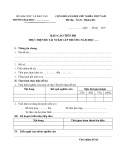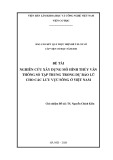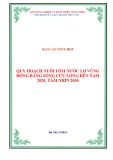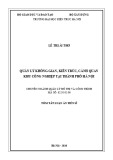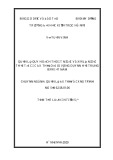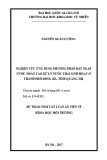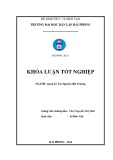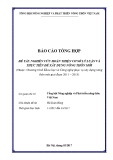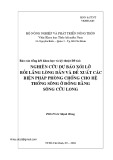International Conference on the Mekong, Salween and Red Rivers:
Sharing Knowledge and Perspectives Across Borders
Hosted by: The Faculty of Political Science, Chulalongkorn University
Research paper
Responses to compensation affected by the Son La hydropower resettlement in Northwestern Vietnam
Prepared by: Pham Van Dung
Culture Identity and Resources Use Management (CIRUM) & LandNet
Edited by: Dr. Krisna Uk, Centre for Khmer Studies (CKS)
12th November 2016
Introduction
ệ
ơ
The Son La hydro electricity power plant is the biggest hydropower development in Vietnam, and is considered a special national construction. This 2,400 MW hydro dam holds a capacity of 9.26 billion cubic meters, and is estimated to flood 23,333 hectares of land, including almost ten thousand hectares of rice paddies, gardens, and fishponds (Dao, 2011). While the construction of the plant was under direct supervision of the government, the Prime Minister and other government officials repeatedly declared they would guarantee the 20,340 households and 93,201 people from 248 villages in the three provinces of S n La, Đi n Biên, Lai Châu affected by the Son La dam that they would gain equal or better life after resettlement (VNPM, 2016). The hydro plant was built during 20052012, and it was stated that its completion was two years earlier than it had been set in the plan. Quick preparations for the resettlement and short time for calculation and disbursement of compensation were the main factors contributing to the earlier completion of the construction. In practice, fair compensation before and during displacement in addition to other suitable and sufficient support mechanisms after resettlement should be the key factors that contribute to the mentioned target achievement set by the government, however.
The building of the Son La hydro electricity dam resulted in the massive resettlement of households, moving people from their ancestral land to very different land and climate conditions. Resettled people are faced to some extent with the issue of justice deriving from resettlement and compensation process. They have been suffering from land shortages caused by their inability to access essential livelihood resources, such as land rights, forest use, and access to fishing. Resettled people demanded adequate and fair compensation for the loss of their traditional land as well as redress to stabilize and improve their life over the long term. Currently, those people face difficulties in meeting agreed livelihood standards, which includes stable income, nontoxic farming, and access to safe drinking water.
Although some research and newspaper articles have attempted to examine the real situation of the resettled communities, greater investigation on the issue of justice of compensation in such resettlement programmes is lacking. To fill this gap, the aim of this research is two folds: 1) to evaluate stated objectives or commitment of ‘equal or better life after resettlement’ and actual circumstances as perceived by resettled households. Specifically, this evaluation consists of: a) issue of timing, dimension and fairness of compensation for resettlement; b) sufficiency of compensation for loss, removal, stabilization and opportunities for future development; and c) opportunities to improve resettled people’s life. 2) To examine the degree of community involvement in planning, decision and suitability of the support mechanism. The results of this research aim at raising voices of the resettled people in response to increasing resources for development in the region. Furthermore, the gap between the perceptions of affected local people and those of the local authorities, hydropower technicians and the media can be better anticipated so as to become a useful source of information, which will help the relevant actors recognize and implement suitable solutions and approaches in the future.
Methodology
This research involves 36 village heads, leaders and villagers from 18 villages, 7 communal leaders, 5 district officers in 4 districts of Son La province and one district of Dien Bien province, 6 provincial officers who attended and spoke at an advocacy meeting as well as 1
2
director of the Son La hydro dam. Among the 55 respondents, 33 were involved in direct interviews and 22 participated in 3 group discussions and presented their views. The researcher started with building relationship and trust among the informants as a foundation for semistructured and indepth interviews. The research involves representatives from different social status, gender and ages, while interviewing village heads and elders brought about history of the community and an overview movement of the village. When interacting with people, the researcher conducted participant observation, note taking, voice recording and photograph taking with the permission of the interviewed participants. The researcher collected data over the course of two fieldtrips trips in early 2016. The first fieldtrip focused on the individual interviews of 16 informants from 7 villages. The second trip opened up some focus group discussions where representatives from 14 different resettled villages affected by the Son La dam were involved. Following the two abovementioned fieldtrips, additional followup interviews were conducted later via telephone in order to get updates and fuller information relevant to the topic. Secondary data was collected in the form of district and communal socialeconomic reports as well as evaluation reports from the resettlement agencies. The collected primary data, including collected interviews of villagers, village chiefs, and local officers were compared to the literature review of the publications and newspaper articles that related directly to the research focus.
Literature review
The analysis of justice in resettlement compensation draws on the 'environmental injustice' framework suggested by Middleton et al (2015), which consists of three modes: 1) distributive justice, relating to fairness of accessing and sharing resources; 2) procedural justice, which refers to how and who is involved in consultation and decision making; and 3) justice as recognition, relating to inclusion and exclusion of a certain group in the development process, in which marginalized groups often face obstacles in accessing natural resources. Middleton et al show that the problems inherent in decisionmaking on food, water, energy nexus often come from unequal power relations, lack of democracy, transparency and public participation (2015: 628). Therefore, it is recommended that a bottomup approach is used and fair decisionmaking and an introduction of the concept of environmental justice in the waterfoodenergy nexus be promoted (Middleton et al, 2015: 645).
There are relevant publications relating to the Son La hydropower plant and its induced resettlement and compensation system. Among them, Nga Dao’s (2011) is a remarkable one. According to Dao, before resettlement, affected people mainly lived and produced food for self-sufficiency (2011: 128). Due to huge numbers of resettled people and a very short time for preparations, compensation and resettlement, the recruited staffs had little knowledge of resettlement process, which resulted in them not being capable enough to operate smoothly. Consequently, land allocation and compensation processes were also very slow. A large number of resettled people found there were still no roads, water or electricity in the resettled sites following their relocation. It even took a year or longer for people to get access to roads and electricity in some resettlement sites. In addition, many resettled people face shortage of water every day (2011: 124). Limited availability of farming land, especially wet-rice fields became a critical issue. Because wet-rice fields were not available, resettled people received hilly subsidiary croplands instead (Dao, 2011: 129). While land cannot be distributed to babies born after the resettlement date, young couples with two small children may receive
3
about 5,000m2 of land that is insufficient to maintain their livelihood if they relied on land only. Therefore, many male labourers leave the village to find work as porters or take on other jobs to earn a living; otherwise their families face hunger. A number of families returned to their pre-resettled villages instead, located forty to fifty kilometers away from the new village in order to seek the remaining land located above the reservoir to grow crops (2011: 130). Dao pointed out that the main reason for the above-mentioned resettlement problems consisted in the under-estimation of the costs of hydropower construction because the designers neglected to account for externalities. Losses of agricultural land and forest and the resettlement itself were calculated and compensated on the basis of prices that were below the market level. This resulted in the project costs being set far lower than any real costs (2011: 132).
Research findings
1. Results from primary data
Table 1 below gives an overview of the three main issues of land, water and compensation for the 18 villages affected by the Son La hydropower plant. It shows that all the visited villages are facing shortage of land, while representatives of 15 villages (88%) claim shortage of water, and people from 16 villages (94%) within the total 18 villages judge the compensation process was unfair.
Table 1: Issues raised by the 18 visited village representatives
# Village Commune, district Shortage of land Shortage of water Unfair compensation
1. Na Nát Yes n/a Yes ệ ườ Na Lay, M ng Lay (Đi n Biên province)
ườ C Peủ ơ M ng Bon, Mai S n Yes Yes Yes 2.
ườ ỳ ả Hé 2 (b n Hé) M ng Chiên, Qu nh Nhai Yes Yes Yes 3.
ườ ỳ M ng Chiên, Qu nh Nhai 4 Yes n/a Yes Hé 1 (Tông T )ở
ườ ỳ Húa L uấ M ng Giôn, Qu nh Nhai Yes Yes n/a 5.
ỳ ẩ Ch u Quân Yes Yes Yes ườ M ng Giàng, Qu nh Nhai 6.
ỳ 7. Nha T ngổ Yes Yes Yes ườ M ng Giàng, Qu nh Nhai
ỳ Phiêng Lèn 1 Yes Yes Yes ườ M ng Giàng, Qu nh Nhai 8.
ỳ Phiêng Lèn 2 Yes Yes Yes ườ M ng Giàng, Qu nh Nhai 9.
4
ỳ 10 Phiêng Lèn 3 Yes Yes Yes ườ M ng Giàng, Qu nh Nhai
ề ằ ỳ 11. Co Ch mặ Chi ng B ng, Qu nh Nhai Yes Yes n/a
ườ 12. Mai Qu nhỳ ơ M ng Bon, Mai S n Yes Yes Yes
13. Noong Luông Cò Nòi, Mai S nơ Yes Yes Yes
14. Hát Lót, Mai S nơ Yes Yes Yes Hoa Qu nh ỳ (Resettlement No. 428)
ề ề 15. Chi ng Yên ọ ơ Chi ng C , S n La city Yes n/a Yes
ỳ 16. Pá Uân Yes Yes Yes ườ M ng Giàng, Qu nh Nhai
ườ ườ 17. Ná M ngườ M ng Trai, M ng La Yes Yes Yes
ậ ộ 18. Nà Tân Tân L p, M c Châu Yes Yes Yes
Total ‘Yes’ 18 15 16
While the above table gives a summary of the visited villages, the following subsections help to clarify each issue in more detail with illustrated quotations and stories from the informants.
1.1. Calculation and coverage full cost of the losses, particularly traditional cultivation
land
Most respondents from the studied villages were not satisfied with the received compensation from the Son La hydropower resettlement scheme. Some people said that they did not get compensated for the loss of their kitchen, animal facilities and toilets. A number of people expressed at the meetings and interviews that they did not get fair and timely compensation for the loss of their traditional forestland. The informants said that they have not been compensated for the loss of production forestland or rotational cultivation land, which exists above the height of 218m above sea level, or the submerged water level of the Son La reservoir.
1.2. Compensation for different sections of resettlers
People and local officers raised the question of lower land compensation in Son La province in comparison to what has been done in Dien Bien or Lai Chau provinces. Because of the formal adjustment of the rate of compensation, people who pioneered the move by relocating earlier said that they received lower payment in comparison to those who delayed their relocation. A respondent commented on the lack of evenness in distributing resettled land “Allocation of residential land in this village is not equal, while some households get 320m2 only, others get 350m2, or 380, or 400m2. Though people want to raise animals, they cannot practice it because of the land being so narrow”.
1.3. Disbursement timing of compensation fund
Timeline for compensation payment and redress for the loss of resettled people are two important factors contributing to fairness of disbursement. A village leader asserted “The
5
government allocated scattered land several times”. So, it is difficult for the villagers to have land available in time to cultivate and make sure they meet their food security needs in the new resettled sites.
1.4. Difficulties faced by resettled people
1.4.1. Shortage of land
ỳ
ườ
ườ
ỳ
There are two types of new resettlement: urban or nonagricultural settlement, and rural or agricultural one. While the urban settlers only get residential land, they face a lot of difficulties in coping with changing jobs, free market and having to adopt an entirely new way of life. For instance, urban resettled people in M ng Giàng commune, Qu nh Nhai district do not have production land except approximately 400m2 of residential land. A village leader in M ng Giàng commune said: “there are 112 households in the village, of which 35 households having salaries or stable income as government staff or retired people. The other 77 households are typically the same poor. As farmers for generation, today we have no land, no money. We do not know what to do, how to live; it is very difficult for us. We are eating today but we do not know what we will have for food tomorrow. Villagers have to sell their labour force, they are worried about their daybyday earning. We expect the government to have policies helping us to have basic production tools to produce and to live”. Another village leader of the same commune commented: “Without production land, almost every household in the village lives a challenging life. Some of us rely on catching fish in the river. In order to get food, we sell our labour force as builder, carpenter, and we provide transportation services at the reservoir. We have no production land, we cannot do anything, we cannot even do livestock raising. We have to work as builders, or vendors in small business such as vegetable sellers. We have now moved here for 7 to 8 years but we have not been given any support to take on nonagriculture jobs”. In a meeting, representatives from three other villages in Muong Giang commune of Qu nh Nhai district described very similar situation with land shortages, labour redundancy, low income as mentioned by the previous villages.
ườ
ỳ
In agricultural or rural resettlement areas, shortage of cultivable land is even more serious than in nonagricultural resettled areas. Land, or basic production tools to ensure stable livelihood is always a precarious issue everywhere in the displaced areas. This statement is clearly expressed by a Noong Luong village elder: “We are facing a lot of difficulties if you look and understand what is inside the community. Though the outside appearance, e.g.: road, employment as laborers, school, etc. looks good, a critical issue is that we really lack land for cultivation. Land in the old village is now submerged; we cannot grow maize there. We would like to raise goats but there is no land available to do so”. Another aspect of the shortage of cultivable land is the quality of the land that allows resettled people to continue the production of what they used to grow in the former village. A villager from Hé 2 village of M ng Chiên commune, Quynh Nhai district said: “we are not happy at all with our living conditions in this new relocation area. We see that our life is harder. Today we only have one crop of rice with an unproductive yield, instead of two crops per year before resettlement”. Moreover, it is not easy for resettled people to find jobs and alternative income sources in order to compensate for the land shortage. A Hoa Qu nh villager in Hat Lot commune, Mai Son district stated: “We only have 8,000 to 9,000 m2 of land allocated to a household of 4 people. We mainly grow maize. Being landless, we have to work as hired laborers in order to get VND 120,000130,000 (USD 5.4 to USD 5.8) per day. However, jobs are only available
6
at certain times, depending the owner’s call. We have a little piece of land, it is not enough for our living”.
1.4.2. Training on new skills and job created for resettlers
Because of land shortage for cultivation, it is necessary to provide suitable training to improve skills and create jobs for resettled people. However, this activity is not recognized by the affected people as a suitable and helpful type of support. A village leader said: “We have to run different small business at the market. The district officials offered us training on growing mushrooms but after the training we found it difficult to practice it because of investment fund shortages. Only 4 households were able to do this job because they themselves contributed a small capital in their business and received funding support to maintain their job”. People from other localities in Dien Bien province shared similar concerns about urban or nonagricultural resettlement. A villager of Na Lay commune, Muong Lay town said: “We do not have stable jobs to do. We have to run different small businesses in town but we do not earn enough for our daily life. Many of our villagers have a lot of debt due to daily food (rice). For our house, we are allocated 300 m2 per household. Everyday we have to go to the river for fishing to earn a living. People do not own a boat for fishing; it means that not everyone can do fishing. Six among 53 households in our village can go fishing. They earn from VND 30,000 (USD 1.35) to VND 150,000 (USD 6.7) per day depending on their luck. Other people work as laborers for companies or landlords. 30% among us have to venture in different small businesses such as vegetables and rice or cake selling, or making furniture and repairing motorbikes, bicycles, or construction work. About 70% of the villagers wish to have land for rice cultivation instead. We are trained for taking up some kind of jobs but we have not found any suitable jobs to do. We have not yet invested in livestock raising to create an income”.
1.4.3. Other social issues
While dealing with land shortage for cultivation and insufficient skills to get a new sustainable job, resettled people face difficulties to raise from poverty. A representative from He 1 village stated that: “There is no rice field in the new resettled village. Since we moved to live here, we have faced a lot of difficulties, and we want to move to another place, but where will we be going now? Who is responsible for us? We find it very difficult to stay here, as we only have 200 to 300m2 of cultivation land per person. This is far to be enough for production to assure daily food”. Stagnation is not merely observed among the middle aged and old people, but also an issue of concern faced by young resettlers. A villager of Noong Luông village commented: “Our living conditions are difficult to improve. We have little land, while our children have no jobs after studying. There are more than 10 youths in the village who graduated from colleges but have not been employed yet. They have no land for farming. Some of them can work for temporary wages because some factories near here are not so economically stable. Getting jobs depends on the situation of the factory owners”.
1.4.4. Building infrastructure and participation of affected people
The resettlement project has created roads, schools, healthcare centers, water system, etc. Resettled people are entitled to access those facilities, however the quality and sustainability of the above mentioned infrastructure is an issue. A villager from Hoa Quynh village said that: “Water (pipe) system was designed to get through a host village, and it was soon broken. Builders and designers did not listen to us when we told them to get the water source from another place, which is closer to our village. Then we had to contribute VND 8 million (USD
7
358) to rebuild the water system to be connected to another water source. Some households had to drill 80mdepth wells to get water, and pay VND 600,000 (USD 26.9) per month for pumping”. This story does not only reflect the lack of quality and sustainability of the compensated constructions, but also the rights of affected people in being consulted and being active decision makers in a resettlement project.
2. Results from secondary data
Table 2 below reflects the main issues identified in 19 villages, which appeared in publications and the media via search engine. Because the retrieved articles focus mainly on land issues, problems related to water or compensation fairness may not have been included although they are issues of great concern in reality. Among the 19 resettled villages found in publications, people in 17 villages (or 89.4%) are facing land shortage. Water shortage is described by 3 villages (15.8%), and unfair compensation is claimed by people in 7 villages (36.8%).
Table 2: Issues of the 19 villages appearing on publications and the media
# Village Commune, district Shortage of land Shortage of water Unfair compensation
ườ 1 Na Nát yes n/a n/a Na Lay commune, M ng Lay district
ườ 2 C Peủ yes n/a n/a ơ M ng Bon commune, Mai S n district
3 ỳ Hé yes n/a n/a Pác Ma Pha Khinh commune, Qu nh Nhai district
̂ 4 Hoa 2 n/a n/a yes ̂ ọ ạ Tân L p commune, M c Châu district
5 Hua Tát yes yes yes Cò Nòi commune, Mai Son ̛ district
6 yes n/a yes Residential area No. 7 Na Lay ward, Muong Lay town
Huoi Luc 1 Muong Bang, Tua Chua yes n/a n/a 7
ề 8 ỳ ỷ Qu nh L yes n/a yes ơ Chi ng Sung commune, Mai S n district
9 Lóng yes yes n/a ề ỳ ằ Chi ng B ng commune, Qu nh Nhai district
10 Nam Voi yes n/a yes Nam Pi commune, Nam Nhun district, Lai Chau
11 Bó yes yes yes Na Lay ward, Muong Lay town
12 H cố yes n/a n/a Na Lay ward, Muong Lay town
8
13 ặ N m Khao yes n/a yes ậ Tân L p commune, Moc Chau district
14 D i 2 ọ yes n/a n/a ậ Tân L p commune, Moc Chau district
ổ 15 Pa So yes n/a n/a Phong Th town of Lai Chau province
ổ 16 ữ ị H u Ngh yes n/a n/a Phong Th town of Lai Chau province
ườ ệ 17 yes n/a n/a Quan Chiêng M ng Lay town of Đi n Biên province
18 ầ ố L m L u n/a n/a n/a ề Ơ ỳ Chi ng n commune, Qu nh Nhai district
ườ 19 Co Đ ớ M ng Lay town yes n/a n/a
17 3 7 Total confirmed
The selected published articles reflect each case separately, and there is not much comments or critiques on the issue of fairness of compensation. Among them an outstanding article released by the Central Institute for Economic Management (CIEM, 2014) challenges the principle of ‘better life in the new resettled sites’. It estimates that tens of thousands of people have been facing difficulties after resettlement; thousands of households have not received enough compensation and support. The article concludes that the resettlement has been conducted in a nontransparent and confused way.
Discussion and conclusion
The research findings show evidences in land shortage, job creation, income condition and infrastructure facilities that undermine the ‘equal or better life after resettlement’ statement made by the government. In reality, all the villagers expressed their strong concern about land availability for current and future generations. Another issue is the change of production, lifestyle and people’s ability to adapt in the new area. Relocated people used to practice self sufficiency when rice field, cultivated lands, streams in the preresettled, original land used to provide them with almost enough food for them to meet their basic necessities. Though it may seem easy to get an income from hired labour in the new marketoriented resettled areas, people may have to pay a lot more for seeds, fertilizer, rice, foodstuff, and even electricity for pumping drinking water in postresettled sites in comparison to the former villages. Thereafter it is not possible to conclude that people have better consumption capacity and savings after resettlement. Moreover, as described by some informants, resettled people also face potential debts trying to compensate for other shortages
The primary and secondary data shown in the above two tables are almost correlated in terms of land shortage faced by resettled people. They reflect the critical issues found almost everywhere in the resettled communities. Although the issue of water shortage and compensation fairness was less identified in the secondary data, it does not mean that these
9
issues do not exist. The reason is more likely that published articles concentrated on issues of greatest concerns (i.e. land) while other issues were relatively neglected.
Drawing on found evidences and supported facts, it is reasonable to conclude that the compensation scheme of the Son La hydropower resettlement has not been fully calculated and anticipated according to the affected people. In addition, resettled people are facing a number of difficulties, especially shortage of production land, water, unemployment, degradation of road and other infrastructure, lifestyle change and the rights of people to be consulted and take an active part in development projects. The principle of ‘better life after resettlement’ remains uncertain, which requires the government and the relevant hydropower operator to address proactively. Therefore, the stabilization and improvement of the resettled people’s life is a long journey, which needs sufficient energy, expertise, consultation and further financial resources.
The case of the Son La hydropower plant is a useful case study for future hydropower schemes in the Mekong region and elsewhere not to replicate. In order to avoid discrepancies in compensation and the poor performance of resettlement projects, it is highly recommended that full cost is calculated that will cover all losses as well as the cost of resettlement, stabilization and improvement of resettled people. Better social and environmental impact assessment should also be conducted before approval is given to a hydropower project. This process can only be completed well whenever the norm of FPIC (Free, Prior Information Consent) and participatory consultation of the affected people are ensured. To stabilize and improve the livelihood of resettled people in an effective manner and to secure suitable design, planning and implementation of the supporting project, people’s participation in decisionmaking remains a priority.
References
Biggs, E.M.; Bruce, E.; Boruff, B.; Duncan, J.M.A.; Horsley, J.; Pauli, N.; McNeill, K.; Neef, A.; Van Ogtrop, F.; Curnow, J.; Haworth, B.; Duce, S. and Imanari, Y. (2015). Sustainable development and the water–energy–food nexus: A perspective on livelihoods. Environmental science & policy 54: 389397.
ữ ấ ỷ ệ ố ớ ộ ừ ư ạ ị ề CIEM (Central Institute for Economic Management – a state funded agency). (2014). Nh ng v n đ i các công trình thu đi n (Issues of công tác tái đ nh c t
ặ đ t ra đ i v i an sinh xã h i t social security induced by hydropower plant resettlement). Retrieve from: http://www.vnep.org.vn/Upload/Tai%20dinh%20cu%20thuy%20dien.pdf
ồ ư ự ỷ ệ ườ ươ ồ ơ CIRUM (Culture Idendity and Resources Use Management). (2016). Báo cáo ‘Lòng dân, lòng h , ồ ng trình Tái đ nh c D án Thu đi n S n La (Report on i” Ch
ị tr ng cây, tr ng ng people’s perception, watershed situation, plantation and life improvement of the Son La hydro resettlement). Hanoi, Vietnam. CIRUM archive.
́ Dao, Nga. (2011). Damming Rivers in Vietnam: A Lesson Learned in the Tây Băc Region . Journal of Vietnamese Studies.
ồ ủ ệ ở ơ vùng lòng h th y đi n S n La. Duc Tuan. (2016). Chuy n Nhan Dan newspaper (formal media).
ệ Published 5 June 2016. Retrieved: http://www.nhandan.com.vn/phongsu/item/29785202 chuyenovunglonghothuydiensonla.html
Middleton, C.; Allouche, J.; Gyawali, D. and Allen, S. (2015). The rise and implications of the water energyfood nexus in Southeast Asia through an environmental justice lens. Water Alternatives 8(1): 627654.
10
Middleton, C and Dore, J. (2015). Transboundary water and electricity governance in mainland
southeast Asia: linkages, disjunctures and implications. International Journal of Water Governance 01 93120.
ươ ộ c ra ru ng lên n ng (Wish to go to rice field and Tuoitre.vn (a formal media). (2013). Mong đ
ượ slope field). Updated 11 March 2013. Retrieved from: http://tuoitre.vn/tin/ban doc/20130311/mongduocraruonglennuong/537466.html
ủ ướ ả ổ ư ế ị ng: Tái đ nh c không ph i t ng k t VNPM (Vietnam Prime Minister website). (2016). ‘Th t ạ ừ i’ (Prime Minister remarks Closing evaluation does not mean the end of
xong là d ng l resettlement). Updated 1 October 2016. Retrieved from http://thutuong.chinhphu.vn/Home/Thu tuongTaidinhcukhongphaitongketxongladunglai/201610/25434.vgp

